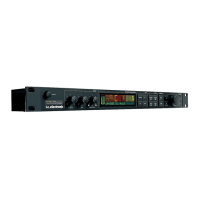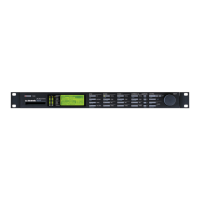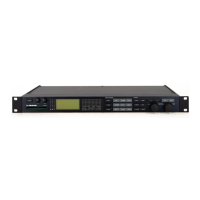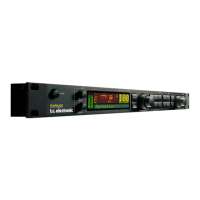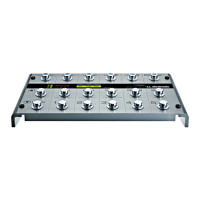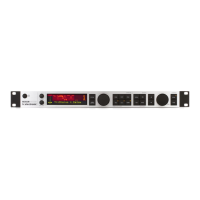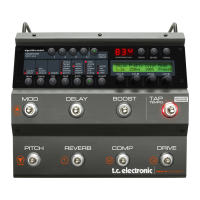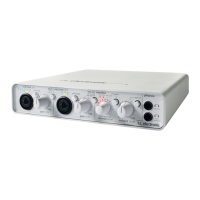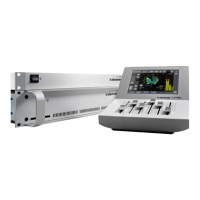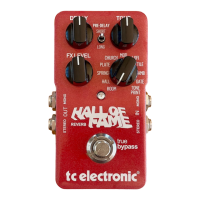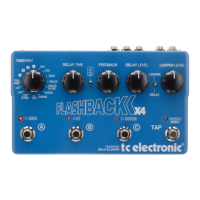Do you have a question about the TC Electronic Impact Twin and is the answer not in the manual?
Key warnings and cautions for safe operation and potential risks.
Highlights core technologies and capabilities like preamps, converters, and connectivity.
Covers unpacking, computer requirements, and software installation steps.
Details FireWire/Power LED, Mic/Inst inputs, PAD/INST, Input LEDs, Gain/Trim, Phantom Power.
Describes Line In selector, ADJUST dialer, and compression mode functions.
Explains Power, FireWire, MIDI, S/PDIF, Line, and ADAT/TOS connections.
Introduces Channel Strips, Line 3-4, S/PDIF, ADAT/TOS, Reverb, Master, and Patchbay modules.
Explains Parametric EQ, Compression, and De-Esser functionalities within channel strips.
Covers presets, Line, S/PDIF, and ADAT/TOS input modules and their controls.
Details reverb parameters, master module, signal LEDs, and patchbay routing options.
Illustrates connecting speakers, keyboard, headphones, and ADAT interface.
Describes a portable setup with guitar, mic, laptop, and Ableton Live settings.
Explains routing signals for DJ pre-listening and main PA output using Ableton Live.
Details how to use the unit as a standalone mixer with EQ, compression, and reverb.
Shows how to integrate external effects processors using S/PDIF.
Illustrates sending channels via ADAT to an external mixer with ADAT inputs.
Explains loading and saving presets and system settings for the Impact Twin.
Explains buffer size, latency, and their impact on audio performance and dropouts.
Covers DPC spike troubleshooting, operation modes, and ASIO buffer size adjustments.
Details sample rate settings, lock status messages, and software/driver versions.
Guides through the process of updating the device's firmware.
Explains speaker setup, routing, and WDM driver usage in Windows.
Describes how to use the built-in tuner, its modes, and scale selections.
Discusses bus power limitations, 4-pin connectors, and multiple devices on a bus.
Details how ASIO channels are distributed across different sample rates.
Illustrates the signal path through preamps, converters, and digital I/O.
Explains the DICE II chip technology and provides control panel shortcut keys.
Lists comprehensive technical data for inputs, outputs, clock, and general specs.
Key warnings and cautions for safe operation and potential risks.
Highlights core technologies and capabilities like preamps, converters, and connectivity.
Covers unpacking, computer requirements, and software installation steps.
Details FireWire/Power LED, Mic/Inst inputs, PAD/INST, Input LEDs, Gain/Trim, Phantom Power.
Describes Line In selector, ADJUST dialer, and compression mode functions.
Explains Power, FireWire, MIDI, S/PDIF, Line, and ADAT/TOS connections.
Introduces Channel Strips, Line 3-4, S/PDIF, ADAT/TOS, Reverb, Master, and Patchbay modules.
Explains Parametric EQ, Compression, and De-Esser functionalities within channel strips.
Covers presets, Line, S/PDIF, and ADAT/TOS input modules and their controls.
Details reverb parameters, master module, signal LEDs, and patchbay routing options.
Illustrates connecting speakers, keyboard, headphones, and ADAT interface.
Describes a portable setup with guitar, mic, laptop, and Ableton Live settings.
Explains routing signals for DJ pre-listening and main PA output using Ableton Live.
Details how to use the unit as a standalone mixer with EQ, compression, and reverb.
Shows how to integrate external effects processors using S/PDIF.
Illustrates sending channels via ADAT to an external mixer with ADAT inputs.
Explains loading and saving presets and system settings for the Impact Twin.
Explains buffer size, latency, and their impact on audio performance and dropouts.
Covers DPC spike troubleshooting, operation modes, and ASIO buffer size adjustments.
Details sample rate settings, lock status messages, and software/driver versions.
Guides through the process of updating the device's firmware.
Explains speaker setup, routing, and WDM driver usage in Windows.
Describes how to use the built-in tuner, its modes, and scale selections.
Discusses bus power limitations, 4-pin connectors, and multiple devices on a bus.
Details how ASIO channels are distributed across different sample rates.
Illustrates the signal path through preamps, converters, and digital I/O.
Explains the DICE II chip technology and provides control panel shortcut keys.
Lists comprehensive technical data for inputs, outputs, clock, and general specs.
| Type | Audio Interface |
|---|---|
| Input Channels | 2 |
| Preamps | 2 |
| A/D Resolution | 24-bit |
| Sample Rate | 96 kHz |
| Bit Depth | 24-bit |
| Headphone Output | 1 |
| Phantom Power | Yes |
| Direct Monitoring | Yes |
| Analog Inputs | 2 |
| Input Types | XLR, TRS |
| Output Types | TRS |
| USB | USB 2.0 |
| Operating System Compatibility | Windows, macOS |
| Analog Outputs | 2 TRS |
